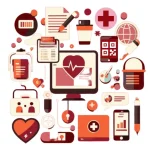
Importance of Sanitation And Hygiene In Healthcare Settings
Sanitation and hygiene in healthcare are essential for maintaining a safe environment. Healthcare facilities that prioritize proper sanitation and hygiene reduce infections, improve patient outcomes, and create a healthier workplace for staff.
Why Sanitation and Hygiene in Healthcare Matter
Sanitation and hygiene in healthcare settings play a critical role in patient safety. Clean environments help prevent the spread of harmful microorganisms, such as bacteria, viruses, and fungi. Without proper sanitation practices, patients become more vulnerable to hospital-acquired infections (HAIs).
These infections can be dangerous and sometimes life-threatening. Reducing HAIs requires consistent cleanliness protocols. Healthcare workers must follow hygiene practices, like washing hands regularly, disinfecting surfaces, and wearing protective equipment. This ensures that infectious agents don’t spread from one patient to another.
1. Better Patient Outcomes
Good sanitation and hygiene practices directly impact patient outcomes. When facilities maintain high cleanliness standards, patients recover faster and with fewer complications. The risk of infection is minimized, and this can lead to shorter hospital stays. In some cases, it can even prevent the need for more aggressive treatments like antibiotics.
2. Protecting Healthcare Workers
Healthcare workers are constantly exposed to infectious diseases. By ensuring proper sanitation and hygiene, they protect themselves and their patients. Handwashing, sterilizing equipment, and following cleanliness protocols reduce the risk of infection for healthcare staff. This also helps maintain a healthy workforce, ensuring that hospitals and clinics run efficiently.
Key Aspects of Sanitation and Hygiene in Healthcare
Several elements contribute to effective sanitation and hygiene in healthcare settings. These practices involve not just cleaning but also creating an environment where infections are less likely to spread.
1. Hand Hygiene
Hand hygiene is one of the most effective ways to prevent infections. Healthcare workers must wash their hands frequently and thoroughly, especially after patient contact. This simple act significantly reduces the chances of spreading germs.
Using alcohol-based hand sanitizers or washing hands with soap and water removes harmful bacteria and viruses. Facilities should ensure that sanitizers are readily available in patient rooms, clinics, and operating theaters, emphasizing the importance of hygiene and health.
2. Cleaning and Disinfecting Surfaces
High-touch surfaces, like doorknobs, bed rails, and medical equipment, must be cleaned regularly. Disinfecting these surfaces kills harmful pathogens, preventing them from spreading to other areas.
Using the right disinfectants and cleaning methods is crucial for maintaining sanitation and hygiene in healthcare. These protocols should be strictly followed, with staff receiving regular training on the latest cleaning techniques and products.
3. Proper Waste Disposal
Handling and disposing of medical waste correctly is another vital part of healthcare sanitation. Waste, including used syringes, bandages, and other medical materials, must be disposed of safely to avoid contamination.
Healthcare facilities should follow strict guidelines for waste management, ensuring that hazardous materials are separated and treated before disposal. This practice helps reduce the risk of environmental contamination and protects both patients and staff.
Impact of Poor Sanitation in Healthcare Settings
Neglecting sanitation and hygiene in healthcare can have dire consequences. One of the most significant dangers is the increase in HAIs, which can lead to severe complications or even death.
1. Hospital-Acquired Infections (HAIs)
HAIs are infections patients get while receiving treatment in a healthcare facility. These infections can be caused by bacteria, fungi, or viruses and are often resistant to antibiotics, making them difficult to treat. Common types of HAIs include:
- Urinary tract infections (UTIs)
- Surgical site infections
- Pneumonia
- Bloodstream infections
These infections usually occur due to poor hygiene practices, like improper handwashing or failure to sterilize equipment.
2. Increased Healthcare Costs
Poor sanitation for hospitals settings also leads to higher costs. Treating HAIs requires additional medical resources, including medications, extended hospital stays, and sometimes complex surgeries. Preventing infections through proper hygiene is far more cost-effective than dealing with the consequences of poor sanitation.
3. Risk to Vulnerable Patients
Patients with weakened immune systems are particularly vulnerable to infections. This includes the elderly, infants, and those with chronic conditions. In healthcare settings, where sanitation is not prioritized, these patients are at a higher risk of contracting dangerous infections.
Essential Practices for Effective Sanitation and Hygiene in Healthcare
To ensure proper sanitation and hygiene in healthcare, facilities must implement several best practices. These protocols help maintain a clean and safe environment for everyone.
1. Training Healthcare Workers
Continuous training for healthcare staff is crucial. Workers need to stay updated on the latest cleaning techniques and infection control measures. Regular workshops and hands-on training sessions can significantly improve overall hygiene standards.
2. Monitoring and Compliance
Implementing sanitation policies is essential, but so is ensuring compliance. Facilities should regularly audit their hygiene practices to identify areas for improvement. Monitoring the cleaning routines, hand hygiene practices, and waste disposal methods helps prevent lapses in sanitation.
3. Patient Education
Patients can also play a role in maintaining sanitation and hygiene in healthcare. Educating them on the importance of cleanliness, such as washing their hands before meals or after using the restroom, can reduce the risk of infections. This simple step encourages a culture of hygiene in healthcare environments.
4. Sterilization of Medical Equipment
Medical equipment like surgical tools, catheters, and IV lines must be sterilized after every use. Proper sterilization kills any lingering pathogens that could infect the next patient. Using autoclaves and other sterilizing devices ensures that medical tools remain safe for use.
Challenges in Maintaining Sanitation and Hygiene in Healthcare
Despite the importance of sanitation and hygiene in healthcare, there are several challenges that facilities face in maintaining these standards. Some of the common obstacles include:
1. Resource Limitations
Not all healthcare facilities have the necessary resources for proper sanitation. Limited funding can result in a lack of cleaning supplies, disinfectants, or trained personnel. This is especially true in low-income areas or developing countries, where healthcare facilities often struggle with inadequate sanitation infrastructure.
2. Staffing Issues
Understaffed hospitals and clinics may find it difficult to maintain strict hygiene protocols. When there aren’t enough workers to clean or enforce sanitation measures, lapses in hygiene are more likely. Ensuring adequate staffing is crucial to keep up with the demands of healthcare sanitation.
3. Lack of Awareness
In some cases, healthcare workers may not fully understand the importance of sanitation and hygiene in healthcare. This can lead to poor compliance with hygiene protocols. Regular training and education are necessary to create a culture of cleanliness in healthcare settings.
Role of Technology in Improving Sanitation in Healthcare
Advances in technology have made it easier for healthcare facilities to maintain sanitation and hygiene. From automated hand sanitizers to disinfecting robots, technology is playing a significant role in enhancing healthcare cleanliness.
1. Automated Cleaning Systems
Robotic systems are increasingly being used in hospitals to disinfect rooms and operating theaters. These systems use ultraviolet (UV) light or hydrogen peroxide vapor to kill harmful microorganisms, providing a more thorough clean than traditional methods.
2. Wearable Devices for Monitoring Hygiene
Some healthcare facilities are using wearable devices to track workers’ hand hygiene practices. These devices alert staff when they need to sanitize their hands, improving compliance and reducing the spread of infections.
Conclusion
In healthcare settings, sanitation and hygiene are not optional—they are essential for protecting patients, staff, and the broader community. Proper hygiene practices reduce the spread of infections, lead to better patient outcomes, and create a safer environment for everyone. By prioritizing sanitation and hygiene in healthcare, facilities can improve patient care, lower infection rates, and reduce healthcare costs.
Frequently Asked Questions
What Is The Importance Of Sanitation And Hygiene In Healthcare?
Sanitation and hygiene in healthcare are critical for preventing infections and ensuring patient safety. They protect both patients and healthcare workers from harmful pathogens.
How Can Healthcare Workers Maintain Proper Hygiene?
Healthcare workers can maintain hygiene by washing their hands frequently, wearing protective gear, disinfecting surfaces, and properly disposing of medical waste.
What Are Hospital-Acquired Infections (HAIs)?
HAIs are infections patients contract while receiving treatment in healthcare facilities. They are often caused by poor hygiene practices and can lead to severe complications.
Why Is Hand Hygiene Important In Healthcare?
Hand hygiene is one of the most effective ways to prevent the spread of infections. It helps reduce the transmission of harmful germs between patients and staff.
Enhance Patient Care and NABH Compliance with LazyMonkey
LazyMonkey is your all-in-one solution for improving patient care, retaining more patients, and meeting NABH standards. Our powerful QR-based feedback tool enables you to capture real-time insights from patient feedback, discharge surveys, staff and doctor evaluations, and clinical research, while also streamlining inter-departmental communication.
Transform your healthcare facility today - reach out to us at [email protected], or request a demo here!
Elevate Your Restaurant Experience with LazyMonkey
LazyMonkey’s QR-based feedback system helps you gather real-time insights from customers, track satisfaction levels, and enhance the dining experience. Get instant feedback on your menu, service, and ambience, and make data-driven improvements to boost repeat customers and reviews.
Improve your restaurant today – reach out to us at [email protected], or request a demo here!
Empower Student Engagement and Campus Improvement with LazyMonkey
LazyMonkey offers a seamless way to gather student feedback, track satisfaction, and enhance campus life. From course evaluations to dorm feedback, our QR-based solution makes it easy to capture valuable insights and improve student retention.
Upgrade your university experience – contact us at [email protected], or request a demo here!
Streamline Feedback and Drive Performance Across Your Enterprise/Franchise with LazyMonkey
Whether you manage one or multiple locations, LazyMonkey’s QR-based feedback system helps you gather real-time employee and customer feedback. Improve operational efficiency, track satisfaction, and make data-driven decisions to enhance brand consistency and growth.
Transform your franchise today – reach out to us at [email protected], or request a demo here!
Enhance Customer Satisfaction and Service Standards in Banking with LazyMonkey
LazyMonkey empowers banks to capture real-time feedback from clients across branches. Improve customer experience, assess service quality, and ensure regulatory compliance with our QR-based solution, helping you retain clients and meet banking standards.
Elevate your bank’s customer care – contact us at [email protected], or request a demo here!
Boost Customer Engagement and Mall Satisfaction with LazyMonkey
LazyMonkey’s QR-based feedback tool enables you to collect feedback from shoppers, track satisfaction, and enhance the mall experience. Gather insights on store services, cleanliness, and entertainment to create an unmatched customer journey.














